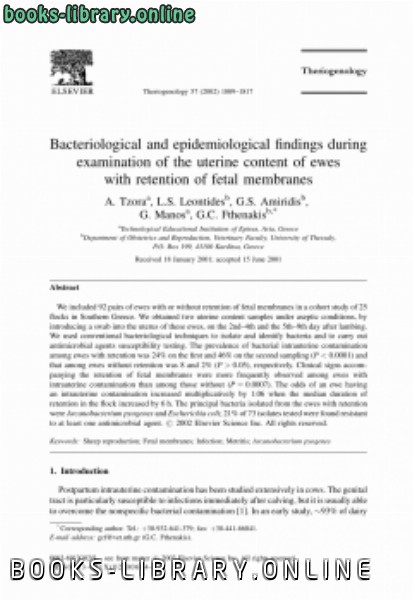📘 قراءة كتاب Bacteriological and epidemiological findings during examination of the uterine content of ewes with retention of fetal membranes أونلاين


Bacteriological and epidemiological findings during examination of the uterine content of ewes with retention of fetal membranes من كتب طب بيطرى
cattlewere found to have avarying degree of bacterial contamination of their uterus during
the early postpartum period, but this decreased to 9% 46±60 days after calving [2]. This is
probably related to the large amount of neutrophils, physiologically found in the uterus
during the early puerperium [3,4]. Various risk factors have been associated with post-
partum uterine infection [5]. Among them, retention of fetal membranes particularly
predisposescowstothedisorder[6];infact,theincidenceofmetritisincowswithretention
has been reported to vary from 37 to 90% [5].
To our knowledge, similar studies do not exist in ewes. Retention of fetal membranes in
ewes, with the small incidence risk of 1.25% [7], has not been studied extensively;
furthermore, no bacteriological investigations of cases of retention have been reported.
This study presents the results of a bacteriological investigation of the uterine content of
eweswithretentionoffetalmembranes.Ourobjectivesweretodescribetheprevalenceand
the identity of bacteria in the uterus of ewes with retention, to investigate their pattern of
susceptibility to antimicrobial agents, and to study the possible association of intrauterine
contamination with some clinical parameters of the disorder. We carried out the investiga-
tion as part of a larger work related to retention of fetal membranes in ewes, carried out in
28 ̄ocks in Southern Greec
حجم الكتاب عند التحميل : 77.9 كيلوبايت .
نوع الكتاب : pdf.
عداد القراءة:
اذا اعجبك الكتاب فضلاً اضغط على أعجبني و يمكنك تحميله من هنا:

شكرًا لمساهمتكم
شكراً لمساهمتكم معنا في الإرتقاء بمستوى المكتبة ، يمكنكم االتبليغ عن اخطاء او سوء اختيار للكتب وتصنيفها ومحتواها ، أو كتاب يُمنع نشره ، او محمي بحقوق طبع ونشر ، فضلاً قم بالتبليغ عن الكتاب المُخالف:
 قبل تحميل الكتاب ..
قبل تحميل الكتاب ..
يجب ان يتوفر لديكم برنامج تشغيل وقراءة ملفات pdf
يمكن تحميلة من هنا 'http://get.adobe.com/reader/'


 منصّة المكتبة
منصّة المكتبة